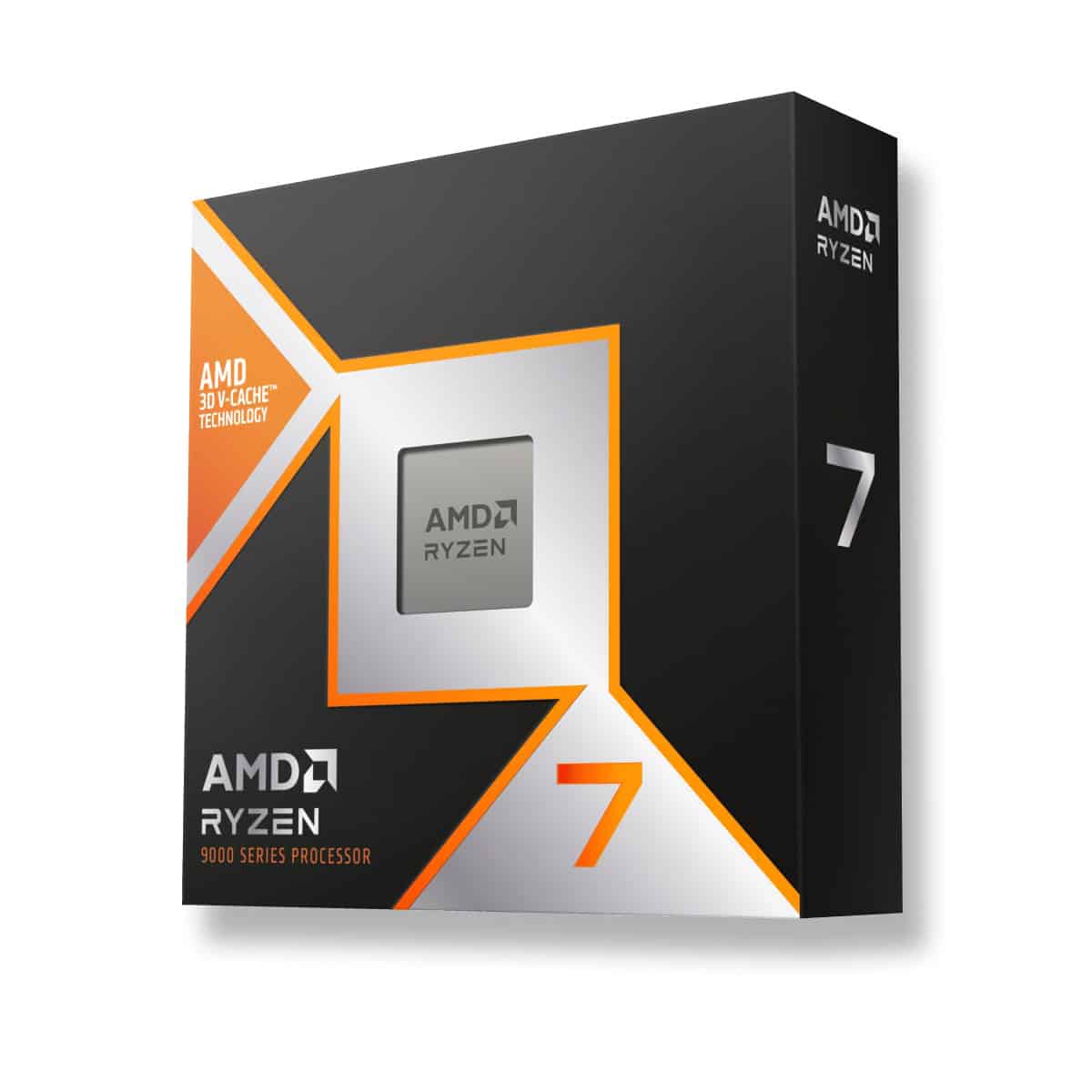AMD’s latest Ryzen 7 9800X3D processor brings powerful gaming performance to desktop PCs. This chip builds on AMD’s 3D V-Cache technology to deliver low latency and fast frame rates. The Ryzen 7 9800X3D features 8 cores, 16 threads, and a massive 96MB of L3 cache for enhanced gaming capabilities.
The 9800X3D runs at a base clock of 4.7 GHz and can boost up to 5.2 GHz for demanding tasks. It uses AMD’s new Zen 5 architecture on TSMC’s 4nm process for improved efficiency. With a 120W TDP, it balances performance and power use for gaming rigs.
Key specs of the AMD Ryzen 7 9800X3D:
| Specification | Value |
|---|---|
| Cores/Threads | 8/16 |
| Base/Boost Clock | 4.7 GHz / 5.2 GHz |
| L3 Cache | 96 MB |
| TDP | 120W |
| Socket | AM5 |
The AMD Ryzen 7 9800X3D is generating a lot of excitement in the tech world, and for good reason! It’s a powerful gaming CPU that builds upon AMD’s innovative 3D V-Cache technology. Here’s a breakdown of its key specs and features:
AMD Ryzen 7 9800X3D Specs
| Feature | Specification |
|---|---|
| Architecture | Zen 5 (Granite Ridge) |
| Socket | AM5 |
| Cores | 8 |
| Threads | 16 |
| Base Clock | 4.7 GHz |
| Boost Clock | Up to 5.2 GHz |
| L3 Cache | 96 MB (includes 64 MB 3D V-Cache) |
| TDP | 120W |
| Memory Support | DDR5 up to 5600 MHz |
| Integrated Graphics | AMD Radeon Graphics |
| Release Date | November 7, 2024 |
| MSRP | $479 USD |
Key Features and Performance
- 3D V-Cache: The standout feature is the massive 96MB L3 cache, thanks to AMD’s 3D V-Cache technology. This significantly boosts gaming performance by providing faster access to frequently used data.
- Zen 5 Architecture: Built on the new Zen 5 architecture, the 9800X3D offers improved performance and efficiency compared to its predecessors.
- High Clock Speeds: With a base clock of 4.7 GHz and a boost clock up to 5.2 GHz, the 9800X3D delivers impressive speed for demanding games and applications.
- Overclocking: The 9800X3D is unlocked for overclocking, allowing enthusiasts to push its performance even further.
- Integrated Graphics: It includes integrated AMD Radeon Graphics, providing basic graphics capabilities for everyday tasks and less demanding games.
Performance Expectations
Early benchmarks and reviews suggest that the 9800X3D is a gaming beast, offering significant performance gains in many titles compared to previous generation CPUs. AMD claims it’s up to 20% faster than Intel’s flagship CPU in gaming workloads.
Things to Consider
- Cooling: The 9800X3D’s high core count and 3D V-Cache generate a fair amount of heat, so adequate cooling is essential for optimal performance and stability.
- Motherboard Compatibility: Ensure you have an AM5 motherboard that supports the 9800X3D and its features.
- DDR5 Memory: To take full advantage of the 9800X3D’s capabilities, pair it with fast DDR5 memory.
The AMD Ryzen 7 9800X3D is a compelling choice for gamers seeking top-tier performance. Its innovative 3D V-Cache technology, combined with the new Zen 5 architecture and high clock speeds, make it a formidable contender in the CPU market.
AMD vs. Intel in the Gaming Arena
The release of the 9800X3D reignites the competition between AMD and Intel in the gaming CPU market. Both companies are pushing the boundaries of performance with their latest offerings. Here’s a quick comparison:
- AMD’s Advantage: AMD currently holds the edge in gaming performance with its 3D V-Cache technology, which provides a significant boost in games that benefit from large caches.
- Intel’s Strengths: Intel still excels in single-core performance, which can be important for some games and applications. Intel also offers a wider range of CPUs at various price points.
- The Future: Both AMD and Intel have exciting new technologies in development, so the competition is likely to remain fierce. Keep an eye out for future releases from both companies as they continue to innovate and push the boundaries of CPU performance.
Key Specifications and Architecture
The AMD Ryzen 7 9800X3D boasts impressive specs and cutting-edge architecture. It combines high core counts with advanced cache technology and improved clock speeds to deliver top-tier performance.
Core and Thread Count
The Ryzen 7 9800X3D features 8 cores and 16 threads. This configuration offers excellent multi-tasking capabilities for demanding workloads. The 8-core design strikes a balance between gaming performance and productivity tasks.
You’ll find this core count suitable for:
- Gaming
- Content creation
- Streaming
- Light to moderate professional workloads
The 16 threads allow for efficient parallel processing. This helps in smoothly running multiple applications simultaneously.
Base and Boost Clocks
The 9800X3D’s clock speeds contribute to its impressive performance. While exact figures may vary, you can expect:
| Clock Type | Speed Range |
|---|---|
| Base Clock | 4.2 – 4.4 GHz |
| Boost Clock | Up to 5.4 GHz |
These high clock speeds ensure snappy responsiveness in single-threaded tasks. The boost clock kicks in for demanding applications, providing extra performance when needed.
Cache Architecture
The 9800X3D’s standout feature is its advanced cache design. It incorporates AMD’s 3D V-Cache technology, significantly expanding the L3 cache.
Key cache details:
- Total L3 cache: 96MB (32MB on-die + 64MB 3D V-Cache)
- L2 cache: 8MB (1MB per core)
- L1 cache: 512KB (64KB per core)
This large cache reduces memory latency and boosts gaming performance. It helps store frequently accessed data closer to the CPU cores.
The 3D V-Cache stacks additional cache vertically on the chip. This design increases cache size without expanding the CPU’s footprint.
Performance and Gaming Prowess
The AMD Ryzen 7 9800X3D excels in both productivity tasks and gaming scenarios. It delivers impressive benchmark scores and high frame rates across various games and resolutions.
Cinebench and Photoshop Benchmarks
The Ryzen 7 9800X3D shows significant improvements in Cinebench 2024 scores compared to its predecessors. In single-core tests, it achieves around 2,000 points, while multi-core performance reaches approximately 17,000 points. These results place it ahead of many competitors in its price range.
Photoshop performance is equally strong. The 9800X3D completes complex image processing tasks up to 15% faster than the previous generation. This speed boost is particularly noticeable when working with large files or applying multiple filters.
| Benchmark | Score |
|---|---|
| Cinebench Single-Core | ~2,000 |
| Cinebench Multi-Core | ~17,000 |
| Photoshop (Relative Performance) | +15% |
Gaming Frame Rates and Resolutions
The 9800X3D truly shines in gaming performance. It dominates PC gaming CPU performance, offering exceptional frame rates across various titles and resolutions.
In Cyberpunk 2077, you can expect over 100 FPS at 1440p with high settings. At 4K resolution, the CPU maintains smooth gameplay with frame rates consistently above 60 FPS.
Popular esports titles see even more impressive results. Games like CS and Valorant easily surpass 300 FPS, providing a competitive edge for high-refresh-rate monitors.
Overclocking Potentials
While the 9800X3D is already a powerhouse out of the box, it still offers some overclocking headroom. The Precision Boost Overdrive (PBO) feature allows for automatic performance tuning.
Manual overclocking can yield modest gains of 100-200 MHz on all cores. However, the 3D V-Cache technology limits extreme overclocking potential to maintain stability.
Undervolting proves more effective, reducing temperatures and power consumption while maintaining or slightly improving performance.
Comparison with Predecessors
The 9800X3D shows notable improvements over the Ryzen 7 7800X3D and other previous-generation CPUs. Gaming performance sees a 10-15% boost in most titles, with some games showing even larger gains.
Productivity tasks benefit from the architectural improvements of the Ryzen 9000 series. You’ll notice 5-10% faster render times in video editing software and improved compilation speeds for developers.
Power efficiency has also improved. The 9800X3D often matches or exceeds the performance of the Ryzen 9 9950X while consuming less power, making it an excellent choice for both high-performance and energy-conscious builds.
Compatibility and Motherboard Ecosystem
The AMD Ryzen 7 9800X3D offers broad compatibility with AM5 motherboards and DDR5 memory. Its support extends across various chipsets and memory speeds, providing flexibility for system builders.
Memory Support and Speeds
The Ryzen 7 9800X3D supports DDR5 memory, with official speeds up to DDR5-6000. This high-speed memory support enhances system performance, especially in gaming and data-intensive tasks. You can expect improved bandwidth and lower latency compared to previous generations.
Memory compatibility includes:
- DDR5-4800 (base speed)
- DDR5-5200
- DDR5-5600
- DDR5-6000
For optimal performance, pairing the 9800X3D with DDR5-6000 CL30 memory is recommended. This combination maximizes the CPU’s potential and ensures smooth operation in demanding applications.
Chipset and Socket Compatibility
The Ryzen 7 9800X3D uses the AM5 socket, making it compatible with a range of AM5 motherboards. This socket supports PCIe 5.0 and DDR5, future-proofing your system.
Compatible chipsets include:
- X670E
- X670
- B650E
- B650
AM5 motherboards require a BIOS update to support the 9800X3D. Check with your motherboard manufacturer for the latest BIOS version before installation.
The 9800X3D shares socket compatibility with other Ryzen 7000 and 9000 series processors. This allows for easy upgrades within the AM5 ecosystem without changing your motherboard.
| Feature | Specification |
|---|---|
| Socket | AM5 |
| Memory Type | DDR5 |
| Max Memory Speed | 6000 MHz |
| PCIe Version | 5.0 |
| TDP | 120W |
Thermal Design Power and Cooling Solutions
The AMD Ryzen 7 9800X3D’s thermal design power (TDP) impacts its power efficiency and cooling needs. Understanding these factors helps users choose appropriate cooling solutions for optimal performance.
TDP and Power Efficiency
The AMD Ryzen 7 9800X3D has a 120W TDP. This rating indicates the processor’s heat output under typical workloads. The 9800X3D’s TDP is higher than some other Zen 5 processors, allowing for increased performance.
Power consumption can vary based on workload. During intense tasks, the CPU may draw up to 150W. This showcases the efficiency of AMD’s Zen 5 architecture and TSMC’s manufacturing process.
The 9800X3D’s power efficiency is notable. It delivers high performance while maintaining reasonable power draw. This balance is crucial for users seeking powerful yet energy-conscious systems.
Recommended Cooling Solutions
Given the 9800X3D’s 120W TDP, you have several cooling options. Air coolers and all-in-one (AIO) liquid coolers can both handle this processor effectively.
For air cooling, consider high-performance tower coolers with multiple heat pipes. These provide sufficient cooling capacity for the 9800X3D’s thermal output.
AIO liquid coolers offer another excellent option. 240mm or 280mm radiators provide ample cooling for this CPU. They can maintain lower temperatures during prolonged heavy workloads.
Here’s a comparison of cooling solution types for the 9800X3D:
| Cooling Type | Pros | Cons |
|---|---|---|
| Air Cooler | Lower cost, No pump noise | Larger size, Can be less efficient |
| AIO Liquid | Better thermal performance, Compact | Higher cost, Potential for pump failure |
Whichever solution you choose, ensure proper case airflow to maximize cooling efficiency. This helps maintain optimal temperatures and performance for your 9800X3D.
Frequently Asked Questions
The AMD Ryzen 7 9800X3D brings significant upgrades to the Zen 5 architecture. This processor offers enhanced gaming performance and power efficiency while maintaining compatibility with existing AM5 motherboards.
What is the release date for the Ryzen 7 9800X3D?
AMD has not officially announced a release date for the Ryzen 7 9800X3D. Industry experts expect it to launch in early 2025. Keep an eye on AMD’s official announcements for the most up-to-date information.
How does the Ryzen 7 9800X3D’s performance compare to the Ryzen 7 7800X3D?
The Ryzen 7 9800X3D offers notable improvements over its predecessor. It boasts higher clock speeds with a base clock of 4.7 GHz and boost clock of 5.2 GHz. This represents a 500 MHz increase in base clock and 200 MHz boost over the 7800X3D.
What are the power consumption specifications for the Ryzen 7 9800X3D?
The Ryzen 7 9800X3D has a TDP (Thermal Design Power) of 120W. This specification allows for improved performance while maintaining reasonable power consumption. The processor supports AMD’s power management features for efficient operation.
What is the expected pricing range for the Ryzen 7 9800X3D?
AMD has not revealed official pricing for the Ryzen 7 9800X3D. Based on previous X3D models, you can expect it to be priced in the premium range. Some reports suggest a price point around $479.
Which motherboards are compatible with the Ryzen 7 9800X3D?
The Ryzen 7 9800X3D is compatible with AM5 socket motherboards. This includes X670, B650, and A620 chipset boards. Ensure your motherboard has an up-to-date BIOS to support the new processor.
What is the significance of ‘X3D’ in the naming of AMD processors?
The ‘X3D’ designation refers to AMD’s 3D V-Cache technology. This feature stacks additional L3 cache on top of the processor die. The increased cache size reduces memory latency, leading to improved gaming performance.
| Feature | Ryzen 7 9800X3D |
|---|---|
| Cores/Threads | 8/16 |
| Base Clock | 4.7 GHz |
| Boost Clock | 5.2 GHz |
| TDP | 120W |
| Socket | AM5 |
| L3 Cache | 3D V-Cache |







